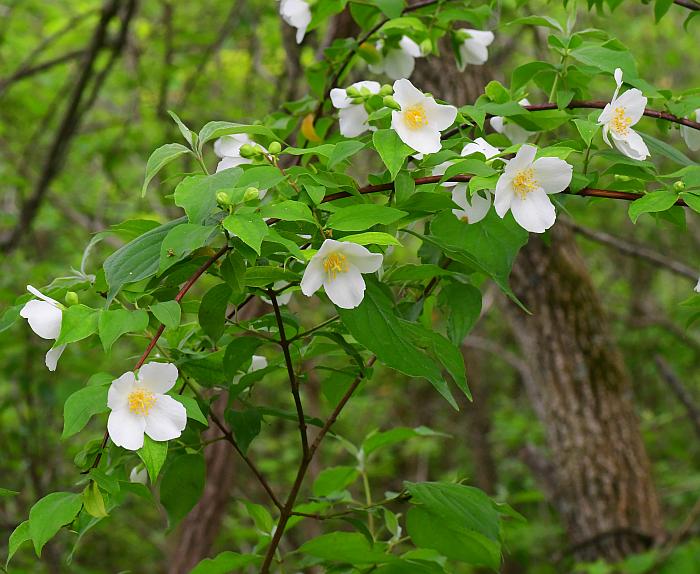Philadelphus inodorus L.
Scentless Mock Orange

Introduced
CC =
CW =
MOC = 2
© SRTurner
Philadelphus inodorus L.Scentless Mock Orange | |
 |
Introduced CC = CW = MOC = 2 |
© SRTurner |
|
Family - Hydrangeaceae Habit - Shrub to 3 m.
Stems - Arched or spreading to erect, gray or reddish brown, often flaking or peeling in small plates or strips. Leaves - Opposite, simple, short-petiolate. Blades 4-8 cm, oblong to ovate, toothed or entire, rounded or acute at the base, acuminate, glabrous or nearly so.
Inflorescences - 1-3 flowers at tips of branches. Flower stalks 3-8 mm long, glabrous or nearly so.
Flowers - Showy, perfect, usually 4-merous, 3.5-5.5 cm broad. Hypanthium usually glabrous. Sepals ovate or ovate-lanceolate, 7-14 mm long, acuminate to acute at the apex, usually glabrous or nearly so. Petals white, oblong to nearly circular, 15-25 mm long. Stamens numerous. Filaments distinct, 5-11 mm. Styles 4, basally fused, cylindric, 10-16 mm, 4-lobed, the stigmatic surfaces 3.0-4.5 mm. Ovary inferior or nearly so, the hypanthium extending nearly to the broad tip of the ovary, 4-locular.
Fruits - Obconic capsules 1.0-1.3 cm long, the surface smooth, not ribbed, dehiscing longitudinally. Seeds 2-3 mm long, narrowly oblong-cylindric, the body long-tapered to a slender wing, the other end truncate and with a small irregular crown, brown to dark brown. Flowering - April - June. Habitat - Streambanks, bluffs, cliffs, rock outcrops. Also cultivated. Origin - Native to the southeastern U.S., considered introduced in Missouri. Lookalikes - Other species of Philadelphus; Rhodotypos scandens Other info. - This attractive shrub is rare in Missouri, known from only two locations. Both of these probably represent former deliberate plantings. It is more common in states to our southeast. When flowering, the plant is easily recognized as a species of Philadelphus by its large, white flowers. Identification to species can be challenging. This one is characterized by having leaves several cm in length, and 4 style lobes and 60-90 stamens within the flower. Photographs taken at St. Joe State Park, St. Francois County, MO, 5-21-2020 (SRTurner). |